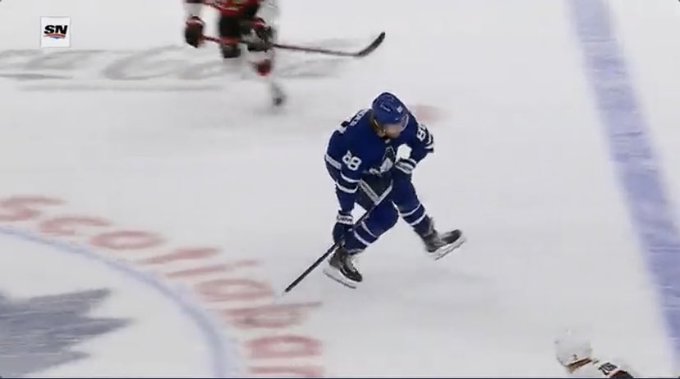McKenna’s Mailbag: Discussing goalie skating, maintenance days and more!

#AskMcKenna did you ever wear a hat over your helmet?
A fun one to start this week’s mailbag! No, I never wore a hat over my helmet. But I also didn’t play in any outdoor games, where it’s become en vogue to do so.
The first goaltender I can think of to wear a winter hat over his helmet was Jose Theodore in the 2003 Heritage Classic when he was playing for the Montreal Canadiens. The game took place at Commonweatlh Stadium in Edmonton against the Oilers and it was freezing cold. Back then, outdoor games were a rather new concept to the NHL and players were trying anything to stay warm.
Theodore’s toque usage was creative and it created a buzz. There’s been a few outdoor games since that have featured temperatures cold enough to require the extra insulation. But even in warm(er) temperatures, some goaltenders still choose to wear one.
It’s really just a fashion statement now. But I think it’s a really cool, unique aspect of outdoor games. I hope goaltenders keep the tradition alive.
@MikeMcKenna56 NHL players make skating look so easy that we often don't realize how skilled they are. How much time should a goalie spend working on their skating skills? #AskMcKenna
A great point about skating. It looks so fluid and effortless watching NHL players. It’s a point that I often make to people when I try to explain why hockey is such a difficult sport. Imagine playing lacrosse AND soccer while moving 20 mph on a set of steak knives.
It’s why hockey players rarely make it to the NHL if they started playing later in life. And by later I mean middle school. It’s a stark contrast to a sport like football, where some NFL players don’t pick up the game until high school. Some make the NFL after only having played the sport for a few years. That’s not how it works with hockey.
As for goaltenders, skating is the single most important skill. Coaches love to use this phrase: “the goalie should be the best skater on the team.”
But why do they say it? Because they heard it from someone else and it sounded good. It’s a cliche. And the coaches that say it usually have no clue what exactly it means.
I’ve had parents ask me if they should put their young goaltender in power skating classes. No. Put them on the ice with a goalie coach who knows how to teach goalie skating. No pucks. Just skating. Starts and stops. Crisp, powerful, precise crease movements. T-pushes. Shuffles. Slides. Recoveries. Goalie skating is about balance and edgework. And proper instruction is necessary.
Goalies should spend at least 10-15 minutes of every practice working on their crease movements. It’s why so many NHL goalies go on the ice early with their goalie coach. It’s the only time they have to work on things from a goalie-specific standpoint.
I know from experience. I was a terrible goalie skater when I was younger – but I didn’t know it. No one ever taught me how. Until I was drafted by the Nashville Predators in 2002 and met their goalie coach, Mitch Korn.
I’ll never forget his words. “Mike. You’re a big man. But you can’t skate,” he told me. “I’m sending you to Buffalo to skate with a guy named Chris Economou. You’re going to spend two weeks there learning how to skate like a goalie.”
It changed my life. Mitch and Econ are two of my dearest friends and mentors. And without their help there’s no way I would have ever played in the NHL. I’m eternally grateful to them.
@MikeMcKenna56 maybe you would like to explain the maintenance day. Who decides, the player or the team? Do all players get a certain number of days? What exact is a maintenance day? #ASKMCKENNA
A lot of times teams will try to downplay the term “maintenance day” like a player is just taking a rest. And sometimes that’s actually true. But more often than not, it means a player has a nagging injury that needs attending to.
Usually it’s something minor. But what maintenance actually means is just that – a chance to do some work under the hood. Players spend a lot of time on the training table throughout the season taking care of various pulls, strains, and other discomforts.
When teammates are on the ice for practice, it’s the perfect time for someone to get looked after in the training room. Missing a practice isn’t a big deal if you’re an important player. And if you can back it up on the ice when the puck drops.
There’s a few people that can ultimately make the call on maintenance days. But usually it’s a group decision. The player and the training staff will talk. Coaches will be informed. Sometimes the team’s athletic trainer will veto any activity. And sometimes the head coach will tell a player to stay off the ice.
There isn’t a set number of maintenance days allowed. So it’s not like a player can just walk in and announce he’s not practicing. However I think every player would love to have that option!
More from Mike McKenna
- Ranking every NHL goalie tandem for 2023-24
- Staring down Lou: How standing up for yourself can change a player’s career
- Why it’s time to embrace ‘gambles’ like the Jake Sanderson contract
- Why we shouldn’t view Sheldon Keefe’s contract extension as a vote of confidence
- ‘Two Sean O’Connors?’ NHL training camps bring the funny – and the weird
